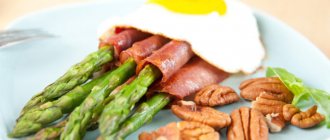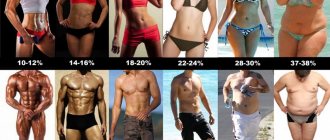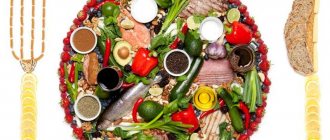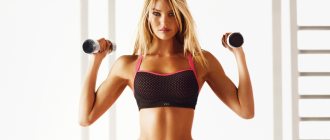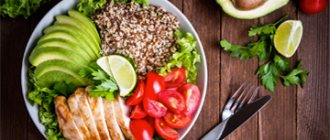Drying the body for 2 weeks is a really working nutrition system that allows you to improve your figure without harming your health. It gets rid of excess fat deposits, but preserves muscle mass, and this is its main advantage over simple diets, which, in addition to burning fat, also reduce muscle volume. Full drying for girls or guys is usually designed for 2-3 months, but we will look at the quick drying menu for two weeks. This system is suitable for people who want to improve their figure, but do not plan to compete in professional competitions.
Main principles
You must understand that effective drying of the body for girls, women or men requires strict discipline, which becomes the main problem for many. It is important to strictly adhere to the menu for weeks, otherwise there will be no result or it will not live up to expectations.
Every day the diet will change, and you must follow it. The basis of drying at home is to reduce the amount of fats and carbohydrates consumed, especially fast ones. Thanks to this, fat reserves begin to be gradually consumed without loss of muscle mass. The diet consists mainly of protein foods, and we must not forget about vitamins and minerals.
Each meal should be small, but you will have to eat not three times a day, but five or six. It is important to meet the increased need for water by drinking up to 2.5-3 liters daily. For best results, weigh your food and count calories.
You need to change your usual diet gradually, gradually removing excess carbohydrates from it. You cannot immediately exclude them, otherwise the body will receive severe stress. Most carbohydrate foods should be consumed in the first half of the day. Additionally, to ensure a safe diet, it is recommended to take vitamin-mineral complexes, since the foods you eat may not contain them in sufficient quantities.
Physical exercises day after day - schedule for half a month
It is best to allocate a fixed amount of time for intense sports activities. For example, an hour before lunch. It is not recommended to exercise on a full stomach; it is unproductive and harmful. It is necessary to alternate between strength and aerobic exercise whenever possible.
The schedule of classes is as follows:
- three times a week (for example, Monday-Thursday-Saturday) circuit training is performed for all muscle groups;
- twice (for example, on Tuesday and Friday), instead of exercise, it is recommended to run for 40-50 minutes at a moderate pace, do race walking, visit the pool, skate or roller skate;
- the remaining two days a week - rest from additional stress.
Attention! When cutting, you should not abuse the intensity of exercise; coupled with a change in diet, this can lead to a deterioration in your health. The desire to see instant results at the cost of exhaustion and loss of tone will not give you a beautiful, toned body, but a bouquet of diseases.

What should circuit training be like? We suggest using a set of exercises that are repeated several times during the “sports hour”. These are “circles”, between which you should take two-minute breaks for rest and relaxation. Individual exercises should also be diluted with short breaks (40-60 seconds each) to restore breathing.
First week – 6 exercises, four circuits
Exercise 1 – squats (on each circle – 20 repetitions)
Legs are shoulder-width apart, feet parallel to each other. When performing a deep squat, your arms should be placed extended in front of your chest (fingers can be intertwined). Do not bend your back, keep it straight.

Exercise 2 – push-ups (10 in a circle)
An exercise familiar from school years. The key to its success is the correct technique. Bending your elbows approximately 90 degrees, you should touch the floor with your chest, not your stomach. The back is straight from shoulders to heels, tense, straightened out. You cannot lift your buttocks.

Exercise 3 – hyperextensions (20 times in each circle)
Lie on your stomach on the floor. Bend your arms at the elbows, clasp your fingers behind your head. Legs – emphasis on toes. Raise the upper part of the body, tearing it off the horizontal surface as much as possible. Hold for a couple of seconds and smoothly return to the starting position. During the exercise, you cannot raise your legs; the deflection in the lower back is the maximum possible.

Exercise 4 – burpees (5 reps in a circle)
Starting position – standing, feet wider than shoulders. Leaning over, we touch the floor with our palms. Jump into a lying position and perform a push-up, placing your torso completely in a horizontal position. Having raised the body, we return to the “bend over, hands on the floor” position. We come out of this stance with a jump, clapping our hands above our heads. We count the claps.
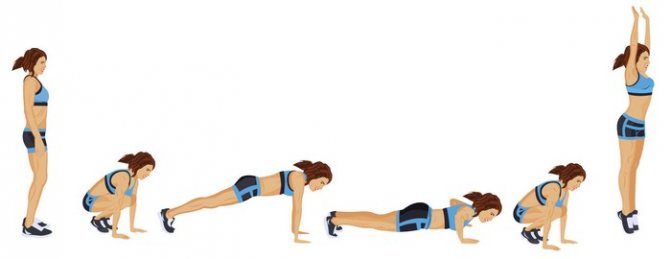
Exercise 5 – sit-ups (25 reps)
Starting position: lie on the floor, stretching your arms straight up behind your head. Bend your legs at the knees, spread your feet wide to the sides. Using your abdominal muscles, raise your body to a sitting position, touching your hands and forearms to the floor between your legs. Then gently lower your torso back to the starting position. Perform the exercise calmly, without jerking, do not move or lift your feet.

Exercise 6 – plank (1 minute)
Focus on the forearms of bent arms and the tips of the feet. The hands are open and lying on the floor. The back is absolutely flat, without bending or sagging. The abs are tense. Breathing is free and rhythmic.
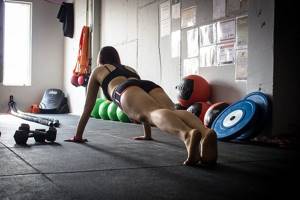
Having completed the first circle, rest for two minutes. Then we repeat all the exercises a second, third and fourth time.
These exercises can be done three times a week. If desired, increase the number of circles to 5-6. Strengthen the effect by jumping rope. And continue this way throughout the drying process. Or choose an enhanced version, changing the exercise in circles, making strength training more regular. If you want to give it your all, then we start the second week with new circles.
Second week - by day of the week
Monday – 5 circuits of 4 exercises
- No. 1 – push-ups (15 repetitions in a row).
- No. 2 – jump squats (20 times).
What products are allowed to dry in 2 weeks?
We will not list the list of foods that need to be excluded from the diet when drying the body - it will take a lot of time, so we will analyze the food that will allow you to achieve positive results. The following proteins are considered optimal:
- lean fish with seafood;
- poultry meat (chicken breast, turkey);
- veal and rabbit;
- legumes;
- eggs (mostly whites);
- dairy products, but low-fat.
As was said, the amount of carbohydrates during drying decreases over 2 weeks, but they cannot be completely eliminated - this is dangerous to health. Sources of healthy carbohydrates for girls and men on a dry diet include durum pasta, cereals, oatmeal, and vegetables. You should also include some fat in the form of olive oil in the 2-week drying menu, and it is also present in meat and fish in small quantities.
Drying menu for 2 weeks for girls and women
Drying programs for men and women are not fundamentally different, but there are some differences, so we will consider them separately. Girls need to gradually reduce the amount of carbohydrates, starting with 2 g per kilogram of body weight.

Therefore, a woman weighing 60 kg needs to reduce the amount of carbohydrates during cutting in the first week to 120 g. There is no strict reference to the amount of proteins (on average 1.5-2.5 g per kilogram), unless you are a performing athlete. For the latter, everything is much more complicated, so we won’t go deeper. Let's consider a drying menu for 2 weeks, which will suit most girls and women.
Week one
Day 1. We have breakfast with a portion of oatmeal without sugar and preferably without adding salt, but you can add a little salt for taste. We also eat two chicken proteins boiled or baked (you can also fry them without oil). For lunch we eat boiled chicken breast, and as a side dish a vegetable salad made from a couple of ingredients (cucumbers with herbs are ideal) and olive oil. In the afternoon we snack on a small portion of buckwheat without butter, and have dinner with baked or boiled white fish, as well as cabbage salad.
Day 2. We start the second day with 2-3 proteins and a couple of tomatoes, and also drink a glass of kefir with minimal fat content. We have lunch with boiled beef with vegetable salad (can be made from pepper, parsley and cucumber with olive oil). In the afternoon we have a snack of boiled fish and half a grapefruit, and dinner with kefir or cottage cheese.
Day 3. Breakfast with a whole boiled egg and buckwheat, lunch with soup with beef, chicken or lean fish. The main thing is that there are no potatoes in the soup. In the afternoon we eat a portion of salad, and have dinner with something protein of our choice: seafood, chicken breast, fish.
Day 4. We start a new day with a serving of oatmeal and a glass of skim milk. We have lunch with stewed squid with sour cream, as well as a small portion of cabbage and pepper salad. In the afternoon we eat some pasta with something protein, and have dinner with cottage cheese and natural unsweetened yogurt.
Day 5. For breakfast we eat rice porridge with water (just boil a couple of spoons), as well as half a grapefruit and unsweetened tea. We have lunch with mushroom soup with herbs and a piece of boiled chicken breast. We have a snack with a salad of greens and cucumber, and dinner with white fish, boiled or baked.
Day 6. You can have breakfast with an omelet made from a couple of eggs or eat two boiled eggs and drink a cup of unsweetened tea. We have lunch with rabbit meat with stewed peas and herbs. For an afternoon snack, a portion of low-fat cottage cheese with a green sour apple, and for dinner, chicken breast, fish or seafood, and kefir.
Day 7. The final day of the first week of drying for girls begins with oatmeal with dried apricots or raisins, and tea. For lunch, fresh veal with sweet peppers. You can have a snack with a vegetable salad, and low-fat cottage cheese for dinner.
It is impossible to accurately indicate portions for each meal, since they depend on the weight of the girls. Use a kitchen scale to weigh your food intake and stay within the above-mentioned carbohydrate and fat limits.
Week two
General principles of nutrition when drying the body at home
The transition to a protein menu should be smooth. Abruptly giving up fats and carbohydrates can significantly harm the body. So the first step is to prepare for drying. Over the course of a month, you should reduce your consumption of flour and sweets, gradually coming to the complete exclusion of sugar, jam, cookies and other “harmful” desserts from the menu.
By the beginning of drying, the diet will also need to be “freed” from:
- animal fats (butter, lard), replacing them with vegetable ones;
- smoked meats, sausages, sausages and all kinds of fast food;
- fried potatoes (the product is allowed only occasionally, for example, in the form of a couple of spoons of mashed potatoes);
- sweets, jams, cakes;
- pickles, marinades, spices - in large quantities.
- soda (primarily sweet).
In no case should you completely eliminate carbohydrates, but their source should be porridge, and occasionally pasta (preferably made from durum wheat). Experts also recommend consuming carbohydrate foods in the first half of the day. You should start the day with a glass of mineral water without gas - this will help push your metabolism in the right direction.
Then meals are organized by the hour, preferably strictly at the same time
Following a routine is important to speed up metabolic processes. If you drank water at 8-00, then the first breakfast will be at 9-00, the second breakfast at 11-00, lunch at approximately 14-00
And so on, every two to three hours, a small portion of food - enough to not experience painful hunger until the next snack.
What foods can and should be used for nutrition during drying?
- Meat. You can’t do without it on a protein diet, but you need to choose low-fat varieties - chicken, beef, rabbit, lean veal. Boiled or steamed.
- Fish – dryish, such as cod or pollock. Can be in the form of cutlets (without adding lard), solyankas, baked in foil.
- Seafood in small quantities - shrimp, squid.
- Low-fat varieties of cottage cheese and kefir, homemade yogurt without added sweets or preservatives.
- Eggs (mainly egg whites) – boiled or as part of ready-made dishes.
- Cereals, legumes.
- Fresh berries and fruits (low in calories), almost any vegetables.
- Green tea is a substitute for morning coffee.
Such manipulations have contraindications - pregnancy, diseases of the gastrointestinal tract, kidneys, cardiovascular system, diabetes. In any case, you should consult your doctor before starting. The duration of drying does not exceed 2-4 weeks; increasing the time is a greater burden for the body. This can lead to negative health consequences.
How should men eat?
For men, the diet for drying for 2 weeks is slightly different. First of all, almost all fats can be excluded from the menu for men. Women need them more due to natural physiology. At the same time, in order to maintain muscle mass, men will have to be more careful about the amount of protein in the menu. Also, representatives of the stronger sex, even during drying after a workout, are allowed some fast carbohydrates in the form of sweets, since at this time the body urgently needs glucose. About an hour after training, you need complex carbohydrates and protein. It is also important to consume a portion of carbohydrates 1-1.5 hours before visiting the gym, otherwise you will not have the energy to perform exercises.
The amount of protein during drying for men should be at least 2 g per kilogram (ideally 2.5-3 g). It is recommended to consume them throughout the day in equal portions of about 30 g at a time, but this is not critical.
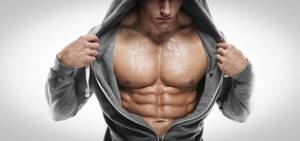
As for carbohydrates, they should be reduced to 2 g or less during drying. Fats are also needed, but in minimal concentration: no more than 0.5 g per kilogram. If we recalculate all this into calories, for a man weighing 85 kg on a 2-week dry diet, the daily menu will contain 1700-1800 kcal. This is not much, so you will experience discomfort, especially if you are used to eating. But with a decrease in the amount of subcutaneous fat, it cannot be otherwise.
To simplify the task, but not at the expense of effectiveness, we recommend a drying menu for men lasting 2 weeks. Let's calculate a diet for men weighing 80-85 kg, from which you can build:
1 day. During the day, eat boiled or baked chicken breast, cottage cheese, fish, vegetables in the form of tomatoes, cabbage, sweet peppers and herbs. Recommended drinks include orange juice, low-fat kefir and milk. Choose the amount of complex carbohydrates from pasta and buckwheat, and for fats, olive oil is suitable as a salad dressing.
Day 2. Form your daily diet from baked fish and chicken breast, egg whites, buckwheat and rice (preferably brown), walnuts and vegetables. You can also eat fruits, including bananas (preferably immediately after training or in the morning), oranges, grapefruit, and green apples.
Day 3. On this day, you can allow yourself a little “extra” in the form of potatoes and an omelet made from whole eggs, not just whites. Also add more vegetables to the menu: peppers, cucumbers, cabbage, tomatoes, herbs. Drink kefir and eat low-fat cottage cheese, as well as tangerines, oranges and kiwi.
Day 4 For the fourth day, the diet consists of buckwheat and durum pasta, beef or veal, vegetables (tomatoes are a must), tomato and orange juice, kefir or natural unsweetened yogurt. Do not forget that carbohydrates should be consumed in the first half of the day, mainly for breakfast, and after lunch only proteins.
Starting from the fifth day of a 2-week drying period, the diet is repeated cyclically. Alternate these days as you wish. The main thing is that you understand the general principles of nutrition and take them into account when creating a menu. It is better if you blindly follow the instructions of nutritionists, periodically deviating from them and not achieving your goals.
How to train for 2 weeks on drying?
There is no need for any complex training programs with tricks to dry the body for 2 weeks for women and men. The main thing is to work hard, giving your all in the gym. Your goal is to tire out your muscles and trigger the natural fat burning process, so focus on cardio. Cutting diets don't force you to go to the gym if you don't have the time or opportunity. Quite regularly (preferably daily, but at least three times a week) go for a run in the park or on the nearest sports ground. Sprinting is not necessary, but leisurely walking will not give results.
When working out in the gym, start each workout with cardio on an exercise bike, orbitrack, stepper or treadmill. The duration depends on your stamina and fitness, but try to aim for 40-60 minutes. You can start with 10-15 minutes, gradually extending the cardio by 2-3 minutes with each workout.

After cardio exercise, work out on exercise machines. Drying does not require performing heavy exercises with extreme weights, but involves working with less weight, but with greater intensity. Athletes call this pumping: each set contains many repetitions with light weights and short rest periods (30-40 seconds).
During such training, the muscles are well filled with blood, and you get the impression of volume and swelling. Short pauses between approaches prevent blood from flowing out, so the effect lasts until the end of the session. Ideally, of course, during drying for 2 weeks for girls, work out with an experienced trainer who will select the optimal load for you, taking into account your physical fitness and gym equipment.
Let's look at several exercises suitable for 2-week drying for girls and women. This program is also suitable for men, but they can add more basic movements. So, you need to do this:
- warm up and stretch;
- we bring our legs together in the simulator - 4 x 25-30 (4 sets of 25-30 repetitions);
- squats with a barbell – 4 x 15-20;
- we bend our legs in the lying machine – 4 x 20;
- pull the vertical block with a wide grip – 3-4 x 20;
- perform hyperextension – 3 to 20;
- do push-ups from the bench or press the barbell while lying down – 4 to 15;
- pump up the press;
- We finish with cardio exercise for 30-40 minutes or more.
As you can see, there are quite a lot of exercises, but due to a short rest between sets, you should fit in about 60-70 minutes without taking into account cardio.
Transition to body drying for girls
The process of switching to “fat burning” training should last 2 weeks.
For the first 2 workouts, work at an intensity of 90% of what you worked with before. That is, if last time you did 5 approaches with 100 kg, working each to failure, set it to 90 kg, and do the same number of repetitions and sets with this weight. On the third workout, you should work with 80 percent intensity. But this time, after your workout, do some exercise on the elliptical. A little - these are 3 “races”; in each, work 1/3 less than the maximum time. The fourth workout is a repetition of the previous weights, sets, repetitions and exercises, but with a greater volume of aerobics. This time you need to do 3 approaches, the last of which will be at full strength. The next workout should consist of exercises for the whole body. Each exercise contains 6 sets of 8 repetitions, but with weights that allow you to perform at least 15 repetitions. Rest between sets – 1.5 – 2 minutes. Aerobic training remains the same.
Advice: Girls, if after such a workout you feel that you are completely ready for the “relief” cycle, start it at the next workout. If you are not ready, repeat the workout, but do not repeat it the next day. Try to always stick to the same order - 3 workouts a week, every other day, with two days of rest after the third. Some women work out every day, but this is only the case when they work out using a split system, that is, they work out one muscle group in one workout.
Note!
- If you quickly switch from a strength training style (medium reps and sets with heavy weights) to a pumping style (many sets and reps with light weights), this can cause damage to your cardiovascular system. There may not be serious consequences (in most cases there are none), but if you do this regularly over several years, negative events such as blood clots or “something like heart failure” are inevitable.
- The same adverse effects can occur if you spend too much time doing aerobics. Aerobics should be moderate. During the period of drying the body, a woman does not need to do “additional” aerobic sessions on days free from athletics. A large volume of aerobic training, even if it speeds up the “drying” process, will be not only a loss of fat, but also muscle. This applies to all women without exception, even those who have had major problems with fat deposits in the past.
- As for nutrition, there is no need to suddenly switch from a “building” diet to a “relief” diet. Such sudden transitions are fraught with harm to the body; especially for the gastrointestinal tract. The correct transition to a protein diet is 7 days of gradual reduction of carbohydrates. These days you need to get used to eating small portions, many times (at least 5) a day.

